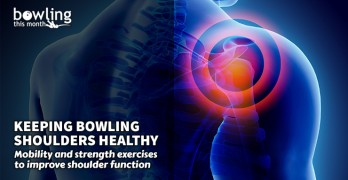Bowling Health and Fitness Articles
Some people might try to tell you that health and fitness are topics that don't matter much to bowlers. The deceptively "simple" motion of throwing a bowling ball often leads them to this conclusion: bowling is certainly a sport that can be successfully enjoyed by the young, the old, the strong, the weak, the overweight, the underweight, the tall, the short, and everything in between. That is really one of the great things about bowling.
Any one of us can easily point out examples of successful bowlers who are out of shape and/or overweight. Whatever you do, however, don't fall into the common trap of thinking that this serves as evidence that fitness isn't important to bowlers! In reality, there are MANY reasons why competitive bowlers should seriously study health and fitness for improving their performance. Here are just a few:
- Improved technique: Some of our sport's movements and techniques are just too difficult for people who aren't as fit as they could be. For example, getting into and maintaining a solid release position with sufficient sliding leg knee bend can be significantly more difficult and stressful for bowlers who are overweight.
- Improved power: In recent years, bowling is increasingly becoming a sport that requires power in the form of high ball speed and high rev rate. When combined with proper technique, improved leg, core, arm, wrist, and hand strength can lead to drastic improvements in the amount of power you transfer to the ball at the release.
- Improved endurance: While bowling isn't a true aerobic endurance sport in the same sense as sports like running, cross-country skiing, and soccer, it does require significant amounts of anaerobic endurance. Anaerobic endurance is what allows our bodies to produce quick bursts of force repeatedly throughout a long tournament block without experiencing fatigue. This kind of endurance can definitely be improved with proper training.
- Injury prevention: Bowling is a very repetitive sport and, worse yet, it tends to be fairly one-sided. This can lead to severe muscle imbalances that can lead to injuries. Bowlers can reduce or eliminate these imbalances with proper training.
We know we can't convince everyone that they can improve their bowling with proper diet and exercise, but we do hope we've convinced you! If you are serious about having a long and successful bowling career, then you owe it to yourself to take care of your body.
Is Your Bowling Game Ready for an Upgrade?
Bowling is evolving, and those who don't keep up will unfortunately get left behind. For over 25 years, our contributors have shared their decades of knowledge and helped our subscribers take their bowling skills to new heights.
Join us as a premium member and get instant access to 872 in-depth instructional articles on all aspects of the modern game, written by some of the best bowling coaches and technical experts in the world.
"I often get ask when participating in Pro Am events what is the place to go for coaching, technical bowling information, or generally how to improve knowledge of the game. I always point them towards BTM, as the knowledge I have learned from BTM's authors and coaches have helped me improve and take my game to a much higher level, including a PBA regional title! Topics from the physical game, to lane play, to ball motion and the mental approach are all covered. It is a must for all serious bowlers who want to improve and continue learning more about the sport we love."





